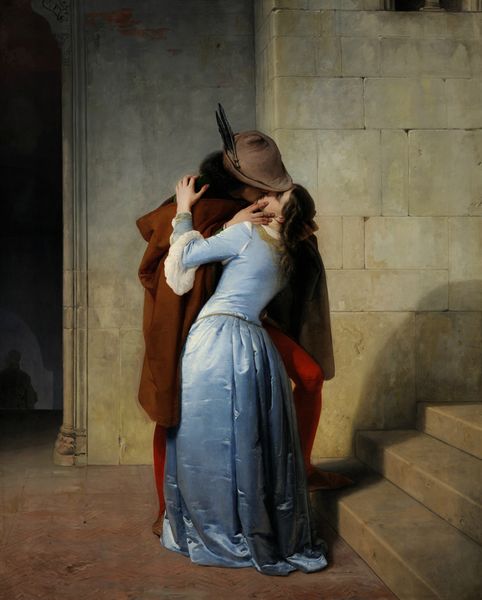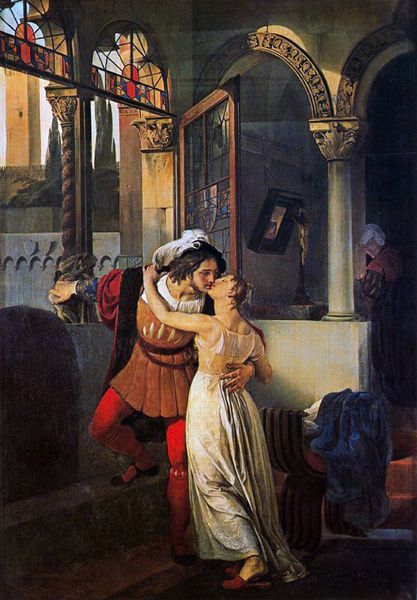A Kiss To Remember - Il Bacio by Francesco Hayez
One of the leading artists of Romanticism in mid-19th-century Milan, Francesco Hayez is celebrated for his grand historical paintings, political allegories, and portraits. The Kiss is possibly his best known work and one of the true icons of Italian Romantic art.
A passionate still, The Kiss conveys the main features of Italian Romanticism and has come to represent the spirit of the Risorgimento, the 19th century political and social movement that resulted in the consolidation of different states of the Italian Peninsula into a single state, the Kingdom of Italy. The painting was commissioned by Count Alfonso Maria Visconti of Saliceto to depict the hopes associated with the alliance between France and the Kingdom of Sardinia.

The Historical and Political Context
After the defeat of Napoleonic France in the 19th century, the 1815 Congress of Vienna redrew the map of Europe, dividing Italy into several states, each ruled or strongly influenced by the Habsburgs of the Austrian Empire. The 19th-century-movement of the Risorgimento was inspired by the realities of these new economic and political forces at work after 1815, the liberal and nationalist ideologies spawned by the French Revolution of 1789, and the ideas of eighteenth century Italian reformers and illuministi.
After the failed revolution in 1848, the secret agreement between Napoleon III, Napoleon’s nephew, and Camillo Benso, Count of Cavour, was formed in 1859, resulting in the defeat of the Austrian armies by the alliance in the Kingdom of Lombardy–Venetia. The unification process took a few years, and the Kingdom of Italy was finally proclaimed in 1861.
The decades of the Risorgimento represent a moment of intense vitality and renewal in the expressive media of Italian art. These works provide an extraordinary dynamic and intensely realistic account of this crucial moment in Italian history and art. Although this is not obvious at first glance, this political was also an inspiration behind Hayez's The Kiss.
The Kiss by Francesco Hayez - Pinacoteca di Brera
The Kiss by Francesco Hayez
At the time, Hayez was very well known among the Italian patriots. As mentioned, The Kiss was commissioned by Count Alfonso Maria Visconti of Saliceto, to depict the appreciation for the alliance between France and Italy that brought about the unification of Italy.
The artist already began to explore the theme of the kiss earlier in his artistic career, when he painted his Last kiss for Julia from Romeo in 1823. Depicting Romeo and Juliet kissing passionately, with his hand on her lower back pulling her closer to him as they embrace, the work caused quite a stir at the time. Prior to this work, the depictions of kisses in art were much more chaste.
A hymn to freedom and patriotic love, The Kiss is a politically charged work, yet Hayez managed to escape any form of censorship thanks to this allegoric depiction. This kiss represents a crucial union of Italy and France. Due to the geometric and perspective scheme set on a series of diagonals, the observer's attention is brought onto the couple. Though at the center of the painting, the couple is not recognizable, as Hayez wanted the action of the kissing to be at the center of the composition.
The male figure is depicted wearing green and red, representing the colors of the Italian flag together with the white drape on the steps, while the female figure’s blue and white garments, held up against the red of the man’s tights, symbolizes the colors of the French flag. Another reading would be a depiction of a young Italian solder going off to fight for Italy against the Austro-Hungarian Empire and kissing his love goodbye. The imminent farewell between the lovers is suggested by the man’s foot temporarily resting on the step, representing both the necessity that he must leave whilst showing the danger of being a patriot. The man also has a dagger hidden in the mantle, signifying the imminent rebellion against the Habsburg invader.
The style in which the painting is created, characterized by the rich color and sumptuous nature of the fabrics, shows the continued influence of Hayez’s early training in Venice. For the Venetians, the color was considered the dominant compositional element in painting. The Venetian idea of colorito is used to describe this priority to the mastery of color pigments and tones, represented in not just rich colors but also naturalistic effects of light.

Several Versions of the Work
Finished in 1859, The Kiss (Hayez) was presented at the Pinacoteca di Brera in Milan, and was later on hung up as a decoration in the luxurious residence of the Visconti family where remained for more than twenty-five years. In 1886, the Count presented the canvas back to the Pinacoteca di Brera, where it is still exhibited today in room XXXVII.
Although this rendition of The Kiss is the most famous, Hayez produced several others as well. In 1861, he painted a version for the Mylius family and sent it to Paris to be exhibited in the Exposition Universelle in 1867, where it was purchased by Grand Duke Vladimir of Russia, younger brother of the future Tsar Alexander III of Russia and uncle of Nicolas II. In this version, the women's dress is painted white instead of blue. Considered to be of equal importance to the Brera version, it was sold at Sotheby's in 2008 by a member of a European royal family to whom the work has passed by direct descent, fetching the sum of 780,450 pounds.
A third oval-shaped version was painted in 1859, being transposed onto watercolor on paper. It was donated by Hayez to Carolina Zucchi and is now exhibited at the Pinacoteca Ambrosiana in Milan. In this version, the artist added a white cloth on the steps beside the couple and used the bright green paint for the man's mantle.
Seeking to emphasize the political and social impact of The Kiss on the young generation of Italians at the time, the patriot and poet Francesco Dall’Ongaro described the painting as "a touching scene, imbued with mystery and affection… from this fond kiss we hope to see the start of a new generation which will be robust, sincere, and which will take life as it comes, and that will fill it with the love for beauty and truth."
Featured image: Francesco Hayez - Il Bacio (The Kiss), 1859. Oil on canvas, 110 cm × 88 cm (43 in × 35 in). Pinacoteca di Brera, Milan.
Can We Help?
Have a question or a technical issue? Want to learn more about our services to art dealers? Let us know and you'll hear from us within the next 24 hours.
